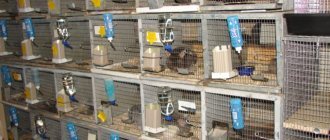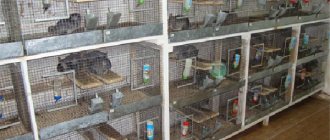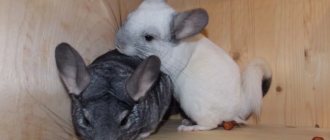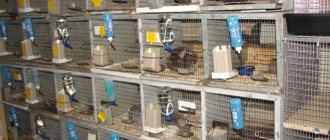Today, chinchilla breeding as a home business is a type of entrepreneurship that has no competitors. Many farmers are interested in raising chinchillas; they ask questions: is it profitable to breed chinchillas, what is needed for business, where to start planning, how to organize the sale of products. Answers to these questions, as well as reviews from experienced entrepreneurs, can be found in this article.
Breeding chinchillas: let's weigh the pros and cons
Advantages of chinchilla business
- This is a relatively free niche in the Russian business sector.
- The demand for our products is constantly growing.
- Good profitability: the cost of maintaining an animal for up to 2 months does not exceed 1 thousand rubles, and the income from each individual is 15 thousand rubles.
- You can start from scratch with minimal effort and without investing a lot of money.
Farm maintenance costs
- Purchase of rodents: at least 10 females and a couple of males (100-150 thousand rubles).
- Home improvement: purchasing equipment (cages and much more can be made with your own hands).
- Food expenses: on average 10 thousand rubles per year per head.
- Electricity costs: light, air conditioning, convector.
- Taxes to the state, state duty for business registration.
- Advertising (may not be required if there are established sales channels).
Comparison with other types of fur-bearing animals
Chinchillas reproduce worse than rabbits and produce no more than 3 cubs in one litter. But chinchilla skin is much more expensive than rabbit skin, because it surpasses it in quality and beauty.
Chinchilla fur is not as durable as mink fur, but a mink coat costs less because it is inferior to a chinchilla coat in several respects: softness, lightness and color range.
Possible risks
- Diseases. The risk of developing the disease in the entire population is very low, since chinchillas have good health and are naturally hardy animals. Serious deficiencies in the care and feeding of pets can lead to an epidemic.
- Lack of distribution channels. This problem will not arise if you think everything through in advance.
Can chinchillas eat meat?
The question of whether wild chinchillas eat “meat” has not yet been resolved. Although it is believed that they may occasionally supplement their diet with insects, no evidence has yet been found for this. What is clear is that chinchillas don't hunt or scavenge, so they don't eat any other meat either.
As is the case when an animal is a herbivore or a carnivore, it cannot switch its diet to whatever it wants. Your chinchilla's intestines are ideally suited to extract as much nutrients as possible from fibrous foods such as grass and hay. By feeding your chinchilla a diet without fiber, you are not meeting its nutritional needs.
So, even if your chinchilla will physically eat the meat you give her, that doesn't mean she should or that she can digest it.
How to organize a business
Purchase of animals and equipment
To start breeding chinchillas at home, you need to purchase the animals themselves and arrange a place for keeping them. For this you will need:
- Cages: 1 cage for 2 rodents, it is recommended to place cages in 2 rows of 6 pieces each, minimum room area – 18 sq.m.
- Drinkers, feeders, hay bowls: nipple drinkers and hanging feeders protect food and water well from contamination.
- Houses and beds: animals need a place for privacy; the size of the bed should not be less than 12 cm in width.
- Filling: Sawdust, shavings or hay.
- Bathing suits and sand: you cannot skimp on sand; the quality of the fur will suffer as a result.
- Toys and exercise equipment for teeth: grinding teeth is vital for rodents; the ideal option is a mineral stone.
- Cleaning and disinfection products: non-toxic specialized products and ultraviolet lamp.
- Convectors: maintaining optimal humidity levels.
- 60 W lamps: per 1 sq.m. 1 lamp required.
- Air conditioning and heater: temperature control.
- Feed and hay.
Business registration
To conduct a business legally, you must register it. Beginning entrepreneurs, if desired, can first register a private subsidiary plot (personal subsidiary plot) and avoid the need to pay taxes. Gradually increasing production volumes, the farmer becomes an individual entrepreneur, and therefore must register the farm with the Federal Tax Service as an individual entrepreneur (individual enterprise). The entrepreneur chooses the type of taxation that is beneficial for him - the Unified National Economic Tax with a rate of 6% of net profit.
In addition to the Federal Tax Service, the business is registered with the local veterinary service.
To run a chinchilla breeding business, you do not need licenses or permits; you only need 2 documents:
- document confirming ownership of the farm;
- registration with the veterinary service.
Chinchilla: breeding for fur, meat and offspring
The destruction of animals in the wild, which put this unique species of animals on the brink of extinction, led to the fact that chinchilla breeding already at the beginning of the 20th century became a profitable business in North and South America, and then in Western Europe.
Chinchilla: breeding for fur, meat and offspring
The animals are very cost-effective to keep and allow breeders to receive:
- unique valuable fur if animals are raised on an industrial scale;
- medicinal dietary chinchilla meat ;
- fast growing offspring with a high percentage of survival of puppies, well adapted to life.
One fur coat requires at least one hundred skins. Animal fur is valued for its lightness, moisture resistance and wear resistance. Fur products made from chinchillas are expensive. All the leading breeders from Western Europe sell their furs at the famous fur auction in Copenhagen.
Chinchilla meat has medicinal properties. It is recommended for use by patients with diseases such as:
- tuberculosis;
- cancer;
- atherosclerosis.
Many restaurants specializing in exotic cuisine willingly cooperate with suppliers of such products, so breeders will be able to sell not only the skins of animals, but also their carcasses.
In addition to adult livestock used for fur and meat, you can sell the offspring, which is also in demand on the market not only among those who start chinchilla fur farms, but also among ordinary people who want to have a pet. The chinchilla is a unique animal that, unlike other rodents and domestic cats, does not smell. It lives long and does not require daily walking, like a dog. When kept at home, chinchillas only need cages, like hamsters and guinea pigs, and they will not cause any odor in the house. The animals are unpretentious and have their own character, which is also important when communicating with your pet.
Business plan
A business plan will help you keep everything under control and get the maximum benefit from your new venture.
First, you should start calculating potential profits: from the amount of expected income (calculated by predicting the receipt of offspring), subtract the amount of estimated costs for the preparation and monthly maintenance of rodents.
Approximate costs of maintaining a livestock of 50 chinchillas:
- Chinchillas - 100-150 thousand rubles.
- Cages – 2 thousand rubles X 25 (2 animals per cage) = 50 thousand rubles.
- Feed – 1,000 – 1,500 rubles per day.
- Other expenses (electricity, taxes, veterinary care, advertising, etc.) – 20 – 30 thousand rubles.
- The income from 50 chinchillas is easy to calculate: offspring of 300 puppies per year will bring about 1 million rubles.
When drawing up a business plan, you should take into account that breeding animals cost about $100, which is 2 times more expensive than pets, and the cost of a skin is approximately $80.
Chinchilla cost and choice of individuals
One of the most important factors for the success of a farm is the correctly selected young animals, that is, individuals suitable for reproduction. Male chinchillas are usually quite expensive, but retain their reproductive functions for 18 years.
Chinchilla coloring has 12 main types. You can choose any of them. The most expensive is the standard, non-mutated color, and black corduroy is a particularly popular high-quality fur among manufacturers.
If you do not want to make a mistake with the choice of animals, it makes sense to contact business owners (that is, factories) that keep more than five hundred chinchillas. Data in the number of individuals are indicated on the official website of any plant of this type (in the declaration or other documents).
How much does a chinchilla cost? The cost of the animal varies depending on its color and age. One individual can cost you either a thousand rubles or 3,000 - 4,000 rubles. Choose the factory where you will purchase animals based on reviews from other suppliers and the number of animals.
Sales of products
Sales channels
Sales of products are possible in three directions:
- breeding animals to other farms;
- skins in studios and factories, as well as at auctions;
- dietary meat can be sold by advertisement or delivered to restaurants;
- small individuals to pet stores.
Beginning entrepreneurs and farmers whose production is constantly growing may need advertising. For these purposes you can use:
- Internet;
- leaflets;
- pet stores.
Do chinchillas eat meat?
Chinchilla meat is eaten, it is dietary and medicinal. It is recommended to be used for cancer, sclerosis and tuberculosis.
Carcasses are sold after the animal is slaughtered for fur.
It is not profitable to specifically raise animals for meat, because even a novice farmer knows how much a rodent weighs—at best, the animal’s weight reaches 1 kg.
Chinchilla weight chart
| Days | Average weight of a chinchilla in grams according to the M.P. table. Pavlova | Average weight in grams Farm table |
| 0 | 41 | 49 |
| 5 | 49 | 59 |
| 10 | 65 | 73 |
| 15 | 72 | 86 |
| 20 | 84 | 101 |
| 25 | 97 | 116 |
| 30 | 114 | 136 |
| 35 | 128 | 154 |
| 40 | 143 | 172 |
| 45 | 158 | 190 |
| 50 | 179 | 215 |
| 55 | 188 | 226 |
| 60 | 201 | 242 |
| 90 | 272 | 327 |
| 120 | 321 | 385 |
| 150 | 362 | 435 |
| 180 | 396 | 475 |
| 210 | 411 | 493 |
| 240 | 422 | 506 |
| 270 | 440 | 528 |
| Adults 505 | Adults 606 |
Reviews from experienced entrepreneurs
Daria, Pskov region
My parents are breeding chinchillas. They started with a small number of individuals, but then they realized that these animals are very profitable, now they have more than 100 heads. The farm is located right on the plot in a special extension. To maintain the heat at least 18 degrees, a heater was installed; it doesn’t turn on that much. Once they forgot to turn it on, 6 chinchillas died. Animals are not fussy about caring for them, but they need to be fed and watered every day and cleaned regularly. The animals eat little and take up minimal space. Parents sell chinchillas to pet stores and sell them online as pets, since they are not involved in skinning.
Fedor, Saratov
When I decided to start farming, I was looking for a business in which I didn’t need to invest a lot right away. Among my friends who breed animals, there is a chinchilla specialist, he explained everything, and it turned out that chinchillas are what I need. I don’t slaughter them for fur; I mainly sell breeding specimens to beginning farmers in Russia and neighboring countries, and sell the rest to a pet store. I am glad that I chose such a profitable path in farming.
Content
This is a heat-loving animal that lives in the dry climate of the highlands of South America, so the easiest way growing chinchillas
- temperature range from +18 to +20 degrees;
- humidity level 50%;
- protection from direct sunlight;
- low illumination of the cage space.
They eat grass and insects once a day in the evening. For proper maintenance, they only need to create the proper conditions once and feed and change the water once a day.
You will also need to clean the cage every day. Cleaning the cells will not cause discomfort and require much effort. The animals do not smell; the sand in which they bathe needs to be changed once a month. The bedding is changed once a week.
A family of one male and one female can live on one square meter. Also, at the first stage, you can create a family of two females and one male.
The animals are fed balanced granular food, which is sold in pet stores, as well as carrots, apples, fresh or dried herbs. When living in apartments, you need to regularly give vitamin complexes to support the immune system.











